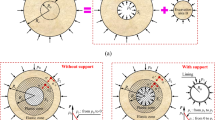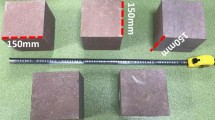Abstract
Several regions of the world have abundant oil shale resources, but accessing this energy supply poses a number of challenges. One particular difficulty is the thermomechanical behavior of the material. When heated to sufficient temperatures, thermal conversion of kerogen to oil, gas, and other products takes place. This alteration of microstructure leads to a complex geomechanical response. In this work, we develop a thermoplasticity model for oil shale. The model is based on critical state plasticity, a framework often used for modeling clays and soft rocks. The model described here allows for both hardening due to mechanical deformation and softening due to thermal processes. In particular, the preconsolidation pressure—defining the onset of plastic volumetric compaction—is controlled by a state variable representing the kerogen content of the material. As kerogen is converted to other phases, the material weakens and plastic compaction begins. We calibrate and compare the proposed model to a suite of high-temperature uniaxial and triaxial experiments on core samples from a pilot in situ processing operation in the Green River Formation. We also describe avenues for future work to improve understanding and prediction of the geomechanical behavior of oil shale operations.









Similar content being viewed by others
Abbreviations
- A :
-
Frequency factor (1/s)
- \({\mathbb{C}}^e\) :
-
Elastic stiffness tensor (Pa)
- \(E_{\text {a}}\) :
-
Primary activation energy (kcal/mol)
- E :
-
Young’s modulus (Pa)
- e :
-
Deviatoric strain (–)
- f :
-
Yield function
- g :
-
Plastic potential
- G :
-
Shear modulus (Pa)
- \(H_{\text {v}},H_{\text {t}},H_{\text {k}}\) :
-
Hardening law coefficients (Pa, Pa/\(^\circ \)C, Pa)
- k :
-
Kerogen content (%)
- K :
-
Bulk modulus (Pa)
- M :
-
Slope of the critical state line (–)
- \({\mathbb{P}}\) :
-
Anisotropic projection tensor (–)
- \(R_{\text {o}}\) :
-
Vitrinite reflectance (%)
- u :
-
Displacement (m)
- \(p_{\text {c}}\) :
-
Preconsolidation pressure (Pa)
- \(p'\) :
-
Mean effective stress invariant (Pa)
- q :
-
von Mises stress invariant (Pa)
- \(q_{\text {A}}\) :
-
Anisotropic von Mises stress invariant (Pa)
- s :
-
Deviatoric stress (Pa)
- T :
-
Temperature (\(^\circ \)C)
- \(\alpha \) :
-
Thermal expansion coefficient (1/\(^\circ \)C)
- \(\beta _{\text {s}},\beta _{\text {c}}\) :
-
Non-associativity multipliers
- \({\boldsymbol{\epsilon}} \) :
-
Strain (–)
- \(\epsilon _{\text {v}}\) :
-
Volumetric strain invariant (–)
- \(\epsilon _{\text {s}}\) :
-
Deviatoric strain invariant (–)
- \(\gamma \) :
-
Elastic softening coefficient (1/\(^\circ \)C)
- \(\dot{\lambda }\) :
-
Plastic multiplier
- \(\nu \) :
-
Poisson’s ratio (–)
- \({\boldsymbol{\sigma '}} \) :
-
Effective stress (Pa)
- 1 :
-
Second-order unit tensor
References
Berchenko IE et al (2006) In situ thermal processing of an oil shale formation using a pattern of heat sources. US Patent 6,991,032 B2
Borja RI, Lee SR (1990) Cam-Clay plasticity, Part I: implicit integration of elasto–plastic constitutive relations. Comp Methods Appl Mech Eng 78(1):49–72
Borja RI (2013) Plasticity: modeling and computation. Springer, New York
Burnham AK, Day RL, Wallman PH, McConaghy JR, Harris HG, Lerwick P, Vawter RG (2011) In situ method and system for extraction of oil from shale. US Patent 7,921,907
Burnham AK, Day RL, Wallman PH, McConaghy JR (2012) In situ method for extraction of oil from shale. US Patent 8,162,043
Burnham AK, McConaghy JR (2014) Semi-open pyrolysis of oil shale from the Garden Gulch Member of the Green River Formation. Energy Fuels 28:7426–7439
Burnham AK (2015) A simple kinetic model of oil generation, vaporization, coking, and cracking. Energy & Fuels. doi:10.1021/acs.energyfuels.5b02026
Closmann PJ, Bradley WB (1979) The effect of temperature on tensile and compressive strengths and Young’s modulus of oil shale. SPE J 19(5):301–312
Drucker DC, Prager W (1952) Soil mechanics and plastic analysis for limit design. Q Appl Math 10:157–165
Duvall FEW, Sohn HY, Pitt CH, Bronson MC (1983) Physical behaviour of oil shale at various temperatures and compressive loads: 1. Free thermal expansion. Fuel 62(12):1455–1461
Duvall FEW, Sohn HY, Pitt CH (1985a) Physical behaviour of oil shale at various temperatures and compressive loads: 2. Thermal expansion under various loads. Fuel 64(2):184–188
Duvall FEW, Sohn HY, Pitt CH (1985b) Physical behaviour of oil shale at various temperatures and compressive loads: 3. Structural failure under loads. Fuel 64(7):938–940
Eseme E, Urai JL, Krooss BM, Littke R (2007) Review of mechanical properties of oil shales: implications for exploitation and basin modelling. Oil Shale 24(2):159–174
Fan Y, Durlofsky L, Tchelepi HA (2010) Numerical simulation of the in-situ upgrading of oil shale. SPE J 15(02):368–381
Kaminsky RD, Symington WA, Yeakel JD, Thomas MM (2014) In situ co-development of oil shale with mineral recovery. US Patent 8,641,150 B2
Laloui L, Cekerevac C (2003) Thermo-plasticity of clays: an isotropic yield mechanism. Comp Geotech 30(8):649–660
Le Doan TV, Bostrom NW, Burnham AK, Kleinberg RL, Pomerantz AE, Allix P (2013) Green River oil shale pyrolysis: semi-open conditions. Energy Fuels 27:6447–6459
Ljungstrom F (1953) Method of electrothermal production of shale oil. US Patent 2,634,961
Mraz T, DuBow J, Rajeshwar K (1983a) Acoustic wave propagation in oil shale: 1. Experiments. Fuel 62(10):1215–1222
Mraz T, DuBow J, Rajeshwar K (1983b) Acoustic wave propagation in oil shale: 2. Modelling. Fuel 62(12):1462–1467
Nova R (1986) An extended Cam Clay model for soft anisotropic rocks. Comp Geotech 2:69–88
Roscoe KH, Burland JH (1968) On the generalized stress-strain behaviour of ‘wet‘ clay. In: Heyman J, Leckie FA (eds) Engineering plasticity. Cambridge University Press, Cambridge, pp 535–609
Schofield A, Wroth P (1968) Critical state soil mechanics. McGraw-Hill, New York
Sweeney JJ, Burnham AK (1990) Evaluation of a simple model of vitrinite reflectance based on chemical kinetics. AAPG Bull 74:1559–1570
US Bureau of Mines (1981) The effect of in situ retorting on oil shale pillars. Open File Report 76–82
Acknowledgments
This work was performed under the auspices of the US Department of Energy by Lawrence Livermore National Laboratory under Contract DE-AC52-07NA27344. Funding was provided by American Shale Oil, LLC, which is a joint venture of Genie Energy and Total S.A. Data were procured from New England Research (White River Junction, VT) and MetaRock Laboratories (Houston, TX).
Author information
Authors and Affiliations
Corresponding author
Additional information
Submitted to the GeoProc 2015 Special Issue of Rock Mechanics and Rock Engineering.
Alan K. Burnham formerly affiliated at American Shale Oil, Rifle, CO, USA.
Rights and permissions
About this article
Cite this article
White, J.A., Burnham, A.K. & Camp, D.W. A Thermoplasticity Model for Oil Shale. Rock Mech Rock Eng 50, 677–688 (2017). https://doi.org/10.1007/s00603-016-0947-7
Received:
Accepted:
Published:
Issue Date:
DOI: https://doi.org/10.1007/s00603-016-0947-7




